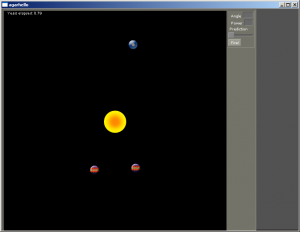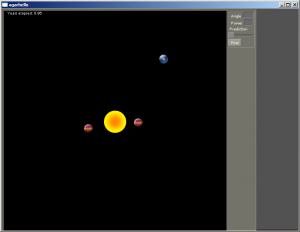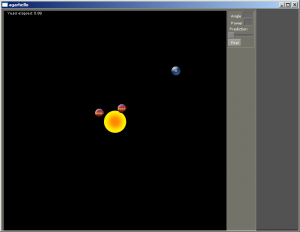### Description
This summer I’ve decided to dedicate some time to working on programming a game. For eight weeks, from June 20th to August 14th, I am planning to put in at least a couple of hours three nights a week. At the end of this time I will evaluate my progress and the state of my project and set further goals.
Now, what is this game that I’m making? At its heart, it’s a 2 dimensional artillery game, like everything from Scorched Earth to Worms to the one with the gorillas that came with QBasic. The twist to what I’m doing is that the entire thing is set in space. Your planet, orbiting the nearby star, is firing upon other planets, also orbiting the same star. Everything is constantly moving. In order to keep confusion under control and to counter the fact that shots aren’t repeatable, I have plans for an interface to allow player’s to simulate where their shots will land. To the best of my knowledge, this sort of game hasn’t been built before. We shall find out if it was for good reason or not.
I’m going to try to post an update on my progress every week or so. Here’s a quick recap of what I’ve done so far.
### Indeterminate Past
Before this all started, I decided one day to write an orbital simulator, just for the fun of it. As I played around with it, I started thinking about making it into an artillery game. After I finished my initial project, and could sit and watch the planets of our solar system make their way through the sky, I wrote some game design ideas and set some development milestones, but didn’t do any more coding.
### Week 1
I got off to a rather slow start. All I finished in the first week was rearranging my old code some so that it looked a bit less like a weekend hack (which it was) and a bit more like the groundwork for a project that could maybe go somewhere.
### Week 2
I’d picked out a few UI libraries I wanted to try integrating things with, so I tried them out to see which to use. At first I tried [Agar](http://libagar.org). I was finding it a bit heavy, and wasn’t sure it was what I wanted, so I decided to try out my other contender, [GiGi](http://gigi.sourceforge.net/). I couldn’t even get GiGi to compile (on Windows), so back to Agar it was. I then had to struggle significantly to get my existing [Cairo](http://cairographics.org/)-based drawing code to output things onto a graphics surface Agar was happy pushing onto the screen. Eventually I got all that done and was left with a solar system app that no longer supported any sort of user input and used more CPU than it used to. All around, a success!
### Week 3
This week I actually started tackling some of the new functionality I wanted to include. I’ve been pulling items off of my to-do list for a (very!) minimally playable demo. I’m going to stick with the philosophy of getting things “playable” as quickly as I can and then keeping them so at all times. This week I have added a placeholder UI, and established the basis of a turn structure by having the physical simulation hooked up to the “Fire” button. Today I finished up support for loading texture images off disk so that my planets don’t have to be flat colored circles anymore.
As a reward for a job well done I set two planets on the same orbit in opposite directions and watched them pull each other into the sun.


